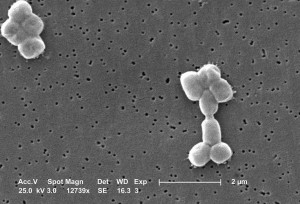
Water is a necessity for all living creatures. Fortunately, most people in the developed world are able to access water directly from the inside of virtually any building. Before entering buildings, water is treated to ensure quality and remove waterborne pathogens. However, in some cases, the conditions within building water systems can allow pathogens to grow in water and cause illness among users.
More About Waterborne Pathogens
Several different pathogens have been found to proliferate in water supplies. Some of these organisms include:
- Legionella pneumophila
- Pseudomonas aeruginosa
- Acinetobacter baumannii
- Cladosporium
- Aspergillus
- Mycobacterium mucogenicum
- Stenotrophomonas maltophilia

These organisms can cause a variety of illnesses, ranging from mild skin infections to fatal cases of Legionnaires’ disease. Depending on the organism, it may cause infection when consumed and/or inhaled by susceptible individuals. To prevent illness, these organisms must be eliminated from water supplies.
Reducing the Risk
Waterborne pathogens are a threat to all types of water supplies, from those serving residential buildings to the water pumped into hospitals and other healthcare facilities. Regardless of the type of facility you manage, you should take steps to reduce the risk of waterborne illness. Some of the strategies you may employ to reduce this risk are detailed below.
1. Treat water with disinfectant.
Standard water treatment protocols are designed to remove microbial contaminants, including those that cause infection in humans. However, once the water enters the distribution system, it is at risk for contamination once again. Treating water inside the water distribution system with EPA-approved disinfectants will prevent pathogens from proliferating and causing infection. Although disinfectants can be useful for eliminating pathogens from water, keep in mind that they can also react with organic and inorganic compounds found in the water to produce by-products. Because some disinfectant by-products can be harmful to humans, they are regulated by the EPA. Concentrations of certain by-products must be kept below specific levels in order to comply with EPA safety guidelines.
2. Perform recommended maintenance.
When equipment is functioning optimally, the risk of waterborne illness decreases. In order to prevent the proliferation of pathogens, clean all components of your water distribution system on a regular basis. Remember to clean all pipes and tanks, as well as the filtration system. Multiple methods of cleaning are available. These methods vary considerably with regard to price and effectiveness. In general, chemical cleaning methods tend to be more expensive than other available methods, but they are also much more effective.
3. Prevent stagnation.
Stagnant water provides an ideal environment for bacterial growth. Prevent water stagnation as much as possible throughout your water distribution system.
4. Address the issue of biofilms.
A biofilm is an accumulation of microorganisms that adheres to surfaces. Biofilms may contain yeast, protozoa, algae and disease-causing bacteria. They are often present in water distribution equipment and may be as much as 4 centimeters thick. When biofilms form, they are often difficult to remove. However, they can be removed from most water distribution system surfaces through the use of specialized chemicals. If you suspect that biofilms have formed within your system, or if they are noticed during inspection, they should be eliminated immediately.
5. Install point-of-use water filters.
In addition to keeping your system clean and treating water appropriately, you can further reduce the risk of waterborne pathogens coming into contact with system users by installing point-of-use water filters in key locations, such as within shower heads and taps. These filters will catch pathogens that may have survived treatment or contaminated the water after it entered your distribution system.
6. Monitor water quality.
One of the most important steps you can take to ensure that your water supply is always safe for users is to monitor the quality of the water continuously. As you evaluate the water, remember to consider all important characteristics and levels including:
- Presence of waterborne pathogens
- Disinfectant residuals
- Water temperatures
- Chlorine levels
- Presence of harmful chemicals
- pH
- Turbidity
- Appearance
- Odor
When problems are detected during evaluation, identify and resolve the underlying issue as soon as possible.
Sources:
Photo credit: Foter / GNU Free Documentation License
Photo credit: www_ukberri_net / Foter / CC BY
http://www.infectioncontroltoday.com/articles/2014/09/managing-the-risk-of-waterborne-hais.aspx

